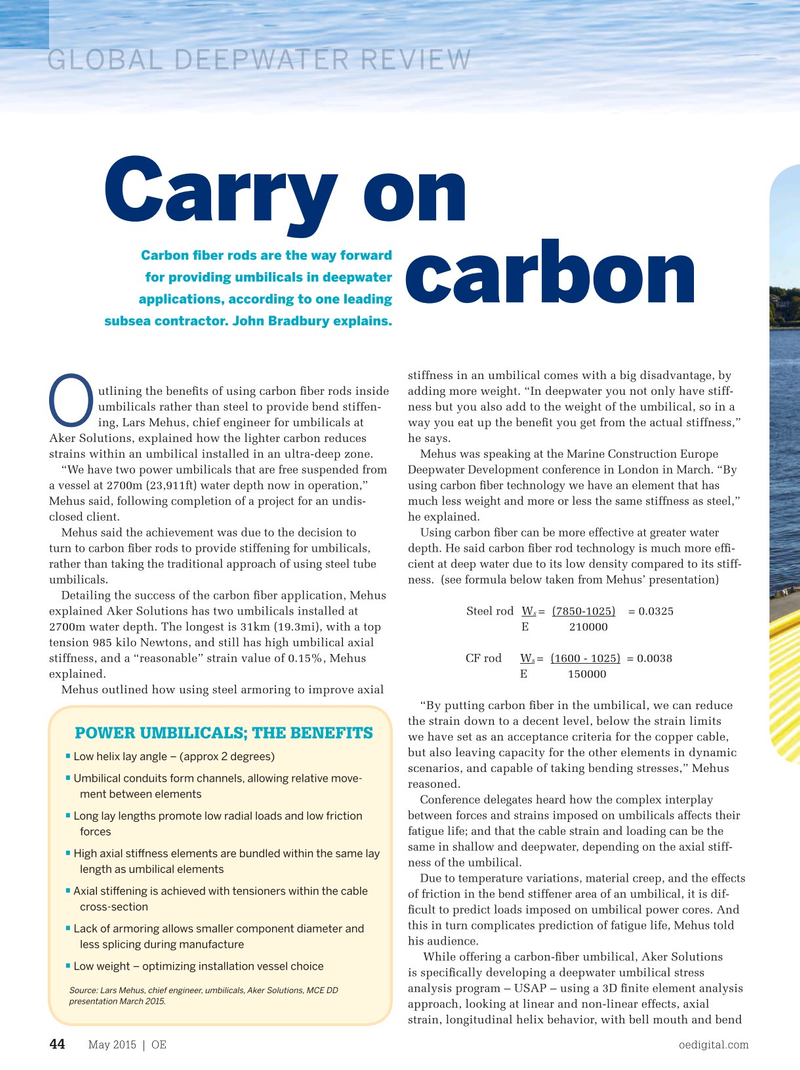
Page 42: of Offshore Engineer Magazine (May/Jun 2015)
Read this page in Pdf, Flash or Html5 edition of May/Jun 2015 Offshore Engineer Magazine
GLOBAL DEEPWATER REVIEWGLOBAL DEEPWATER REVIEW
Carry on
Carbon ? ber rods are the way forward for providing umbilicals in deepwater carbon applications, according to one leading subsea contractor. John Bradbury explains.
stiffness in an umbilical comes with a big disadvantage, by utlining the bene? ts of using carbon ? ber rods inside adding more weight. “In deepwater you not only have stiff- umbilicals rather than steel to provide bend stiffen- ness but you also add to the weight of the umbilical, so in a
O ing, Lars Mehus, chief engineer for umbilicals at way you eat up the bene? t you get from the actual stiffness,”
Aker Solutions, explained how the lighter carbon reduces he says.
Mehus was speaking at the Marine Construction Europe strains within an umbilical installed in an ultra-deep zone.
“We have two power umbilicals that are free suspended from Deepwater Development conference in London in March. “By a vessel at 2700m (23,911ft) water depth now in operation,” using carbon ? ber technology we have an element that has
Mehus said, following completion of a project for an undis- much less weight and more or less the same stiffness as steel,” closed client. he explained.
Mehus said the achievement was due to the decision to Using carbon ? ber can be more effective at greater water turn to carbon ? ber rods to provide stiffening for umbilicals, depth. He said carbon ? ber rod technology is much more ef? - rather than taking the traditional approach of using steel tube cient at deep water due to its low density compared to its stiff- umbilicals. ness. (see formula below taken from Mehus’ presentation)
Detailing the success of the carbon ? ber application, Mehus explained Aker Solutions has two umbilicals installed at Steel rod W = (7850-1025) = 0.0325 s 2700m water depth. The longest is 31km (19.3mi), with a top E210000 tension 985 kilo Newtons, and still has high umbilical axial stiffness, and a “reasonable” strain value of 0.15%, Mehus CF rod W = (1600 - 1025) = 0.0038 s explained. E150000
Mehus outlined how using steel armoring to improve axial “By putting carbon ? ber in the umbilical, we can reduce the strain down to a decent level, below the strain limits
POWER UMBILICALS; THE BENEFITS we have set as an acceptance criteria for the copper cable, but also leaving capacity for the other elements in dynamic • Low helix lay angle – (approx 2 degrees) scenarios, and capable of taking bending stresses,” Mehus
Umbilical load out Moss.
Photo from Aker Solutions.
• Umbilical conduits form channels, allowing relative move- reasoned.
ment between elements
Conference delegates heard how the complex interplay between forces and strains imposed on umbilicals affects their stiffener modeling, and a full catenary model. The USAP • Long lay lengths promote low radial loads and low friction fatigue life; and that the cable strain and loading can be the research is also looking at reeling umbilicals with large center forces same in shallow and deepwater, depending on the axial stiff- tubes, stress control, and installation and temperature impacts • High axial sti

 41
41

 43
43